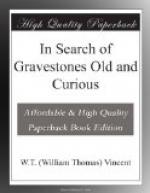perils have been survived by the earlier of those
memorials which remain to us, both without and within
the churches. The dissolution of the Papal power
in Great Britain was the cause of one of these hazards;
for, towards the latter end of Henry VIII.’s
reign, likewise during the reign of Edward VI., and
again in the beginning of Elizabeth’s, commissioners
in every county were vested with authority to destroy
“all graven images” and everything which
seemed to savour of “idolatry and superstition.”
Under colour of this order, these persons, and those
who sympathized in their work, gave vent to their
zeal in many excesses, battering down and breaking
up everything of an ornamental or sculptured character,
including tombs and even the stained windows.
Moreover we are told by Weever[5] that the commission
was made the excuse for digging up coffins in the hope
of finding treasure. Elizabeth soon perceived
the evil that was being done by the barbarous rage
and greediness of her subjects, and issued a proclamation
under her own hand restraining all “ignorant,
malicious, and covetous persons” from breaking
and defacing any monument, tomb, or grave, under penalty
of fine or imprisonment. This checked, but did
not wholly cure, the mischief; and, although in her
fourteenth year of sovereignty she issued another and
sterner edict on the subject, the havoc was perpetuated
chiefly by a sect or party whom Weever describes as
“a contagious brood of scismaticks,” whose
object was not only to rob the churches, but to level
them with the ground, as places polluted by all the
abominations of Babylon. These people were variously
known as Brownists, Barrowists, Martinists, Prophesyers,
Solisidians, Famelists, Rigid Precisians, Disciplinarians,
and Judaical Thraskists. Some who overstepped
the mark paid the penalty with their lives. One
man, named Hachet, not content with destroying gravestones
and statuary, thrust an iron weapon through a picture
of the Queen, and he was hanged and quartered.
Another, John Penry, a Welshman, was executed in 1593,
and of him was written:
“The Welshman is hanged
Who at our kirke flanged
And at her state banged,
And brened are
his buks.
And though he be hanged
Yet he is not wranged,
The de’ul has him fanged
In his kruked
kluks.”
[Footnote 4: The unhealthy practice of using
churches for this purpose was continued some way into
the nineteenth century. The still more objectionable
plan of depositing coffins containing the dead in
vaults under churches still lingers on. In 1875
I attended the funeral (so-called) of a public man,
whose coffin was borne into the vaults of a town church,
and left there, with scores of others piled in heaps
in recesses which looked like wine-cellars. Not
one of the many mourners who shared in that experience
failed to feel horrified at the thought of such a
fate. Some of the old coffins were tumbling to
pieces, and the odour of the place was beyond description.
In the words of Edmund Burke: “I would
rather sleep in the southern corner of a country churchyard
than in the tomb of the Capulets.”]




